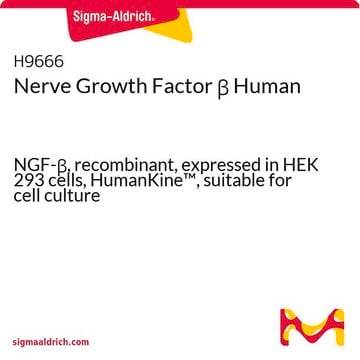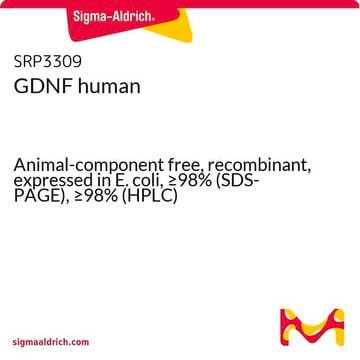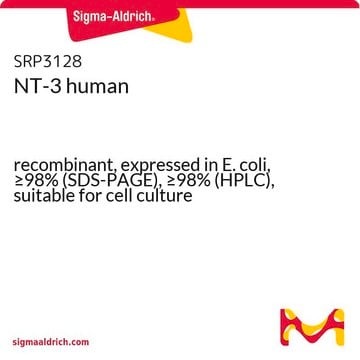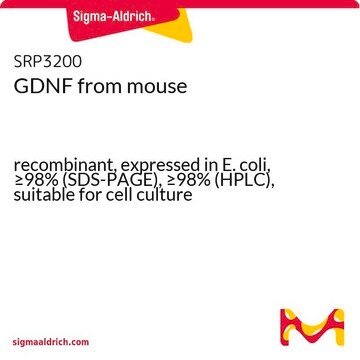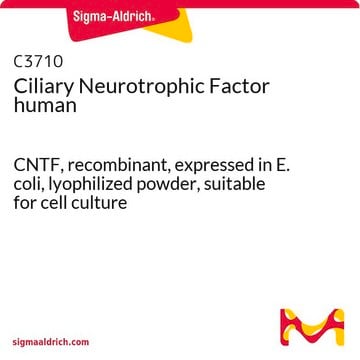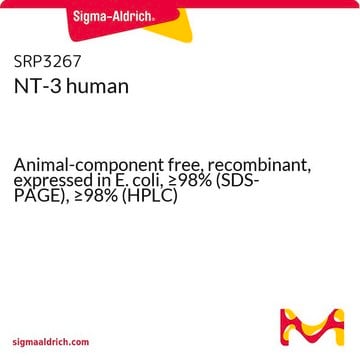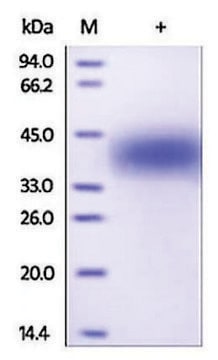G1777
Glial Cell Line-derived Neurotrophic Factor human
recombinant, expressed in E. coli, lyophilized powder, suitable for cell culture, ≥98% (SDS-PAGE)
Synonym(s):
ATF, GDNF
Sign Into View Organizational & Contract Pricing
All Photos(2)
About This Item
Recommended Products
biological source
human
Quality Level
recombinant
expressed in E. coli
Assay
≥98% (SDS-PAGE)
form
lyophilized powder
mol wt
~30 kDa
packaging
pkg of 10 μg
storage condition
avoid repeated freeze/thaw cycles
technique(s)
cell culture | mammalian: suitable
impurities
endotoxin, tested
color
white
UniProt accession no.
storage temp.
−20°C
Gene Information
human ... GDNF(2668)
Related Categories
General description
Glial cell line-derived neurotrophic factor (GDNF) human gene is located on human chromosome 5p13.2.
Application
Glial cell line-derived neurotrophic factor human (GDNF) has been used as a component in the neurobasal medium for neural differentiation. It has also been used for self-renewal, expansion and differentiation of spermatogonial stem cells (SSCs).
Biochem/physiol Actions
Glial Cell Line-Derived Neurotrophic Factor is a member of the cysteine-knot superfamily of growth factors that assume stable dimeric protein structures. GDNF is founding member of the GDNF family of ligands, which to date include GDNF, neurturin (NTN), persephin (PSP) and artemin (ART). GDNF is a glycosylated disulfide-linked homodimeric protein of ~15 kDa. Mature rat and human GDNF share ~93% sequence homology, with strong species cross-reactivity. GDNF signals through a multicomponent receptor system, composed of a RET and one of the four GFRα (α1-α4) receptors. GDNF specifically promotes dopamine uptake and survival and morphological differentiation of midbrain neurons. Using the Parkinson′s disease mouse model, GDNF has been shown to improve conditions such as bradykinesia, rigidity, and postural instability. GDNF promotes survival of various neuronal cells in central and peripheral nervous systems and different stages of development, including motoneurons, midbrain dopaminergic neurons, Purkinje cells and sympathetic neurons. Cells known to express GDNF include Sertoli cells, type 1 astrocytes, Schwann cells, neurons, pinealocytes and skeletal muscle cells. In addition, exogenously applied GDNF has been shown to rescue damaged facial motor neurons in vivo.
Glial cell line-derived neurotrophic factor human (GDNF) acts as a morphogen in kidney development and modulates spermatogonial differentiation. Mutations in this gene may be associated with Hirschsprung′s disease, Tourette syndrome (TS) and attention deficit/ hyperactivity disorder (ADHD). It is used to treat Parkinson′s disease.
Physical form
Lyophilized from a 0.2 μm filtered solution of 10 mM sodium citrate and 150 mM sodium chloride containing 0.5 mg bovine serum albumin.
Analysis Note
The biological activity of GDNF is determined by the dose-dependent dopamine uptake by rat ventral mesencephalic cultures.
Storage Class Code
11 - Combustible Solids
WGK
WGK 3
Personal Protective Equipment
dust mask type N95 (US), Eyeshields, Gloves
Certificates of Analysis (COA)
Search for Certificates of Analysis (COA) by entering the products Lot/Batch Number. Lot and Batch Numbers can be found on a product’s label following the words ‘Lot’ or ‘Batch’.
Already Own This Product?
Find documentation for the products that you have recently purchased in the Document Library.
Customers Also Viewed
GDNF gene is associated with tourette syndrome in a family study
Huertas-Fernandez I, et al.
Movement Disorders, 30(8), 1115-1120 (2015)
Jacob L Roam et al.
Biomaterials, 35(24), 6473-6481 (2014-05-13)
Introduction of spatial patterning of proteins, while retaining activity and releasability, is critical for the field of regenerative medicine. Reversible binding to heparin, which many biological molecules exhibit, is one potential pathway to achieve this goal. We have covalently bound
Novel functions and signalling pathways for GDNF
Sariola H and Saarma M
Journal of Cell Science, 116(19), 3855-3862 (2003)
Generation of Mouse Spermatogonial Stem-Cell-Colonies in A Non-Adherent Culture
Azizi H, et al.
Cell Journal, 19(2), 238-238 (2017)
Gain at chromosomal region 5p15. 33, containing TERT, is the most frequent genetic event in early stages of non-small cell lung cancer
Kang JU, et al.
Cancer Genetics and Cytogenetics, 182(1), 1-11 (2008)
Our team of scientists has experience in all areas of research including Life Science, Material Science, Chemical Synthesis, Chromatography, Analytical and many others.
Contact Technical Service

